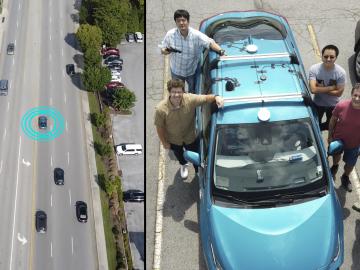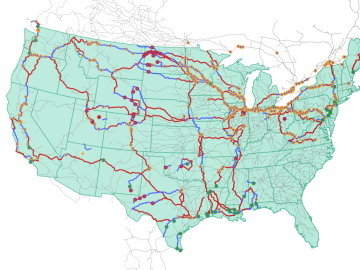
Filter News
Area of Research
- Advanced Manufacturing (1)
- Biology and Environment (19)
- Building Technologies (1)
- Computational Engineering (2)
- Computer Science (10)
- Electricity and Smart Grid (1)
- Energy Science (50)
- Fusion and Fission (1)
- Fusion Energy (7)
- Isotope Development and Production (1)
- Isotopes (1)
- Materials (9)
- Materials for Computing (2)
- Mathematics (1)
- National Security (4)
- Neutron Science (2)
- Nuclear Science and Technology (4)
- Nuclear Systems Modeling, Simulation and Validation (1)
- Quantum information Science (3)
- Sensors and Controls (1)
- Supercomputing (18)
- Transportation Systems (2)
News Type
News Topics
- (-) Advanced Reactors (13)
- (-) Artificial Intelligence (16)
- (-) Clean Water (14)
- (-) Computer Science (42)
- (-) Grid (22)
- (-) Hydropower (6)
- (-) Irradiation (2)
- (-) Machine Learning (14)
- (-) Transportation (36)
- 3-D Printing/Advanced Manufacturing (34)
- Big Data (17)
- Bioenergy (17)
- Biology (21)
- Biomedical (11)
- Biotechnology (4)
- Buildings (21)
- Chemical Sciences (13)
- Composites (11)
- Coronavirus (11)
- Critical Materials (12)
- Cybersecurity (3)
- Emergency (1)
- Energy Storage (32)
- Environment (48)
- Exascale Computing (1)
- Fossil Energy (1)
- Frontier (1)
- Fusion (9)
- High-Performance Computing (12)
- Isotopes (5)
- ITER (3)
- Materials (36)
- Materials Science (34)
- Mathematics (3)
- Mercury (3)
- Microscopy (11)
- Molten Salt (5)
- Nanotechnology (12)
- National Security (3)
- Neutron Science (27)
- Nuclear Energy (19)
- Partnerships (2)
- Physics (4)
- Polymers (10)
- Quantum Computing (5)
- Quantum Science (12)
- Security (1)
- Simulation (9)
- Space Exploration (10)
- Statistics (1)
- Summit (8)
Media Contacts

Electric vehicles can drive longer distances if their lithium-ion batteries deliver more energy in a lighter package. A prime weight-loss candidate is the current collector, a component that often adds 10% to the weight of a battery cell without contributing energy.

Oak Ridge National Laboratory researchers have identified the most energy-efficient 2024 model year vehicles available in the United States, including electric and hybrids, in the latest edition of the Department of Energy’s

ORNL researchers determined that a connected and automated vehicle, or CAV, traveling on a multilane highway with integrated traffic light timing control can maximize energy efficiency and achieve up to 27% savings.

Currently, the biggest hurdle for electric vehicles, or EVs, is the development of advanced battery technology to extend driving range, safety and reliability.

Researchers from Oak Ridge National Laboratory and Northeastern University modeled how extreme conditions in a changing climate affect the land’s ability to absorb atmospheric carbon — a key process for mitigating human-caused emissions. They found that 88% of Earth’s regions could become carbon emitters by the end of the 21st century.

Oak Ridge National Laboratory researchers used images from a photo-sharing website to identify crude oil train routes across the nation to provide data that could help transportation planners better understand regional impacts.

Oak Ridge National Laboratory researchers have developed a method to simplify one step of radioisotope production — and it’s faster and safer.

ORNL scientists found that a small tweak created big performance improvements in a type of solid-state battery, a technology considered vital to broader electric vehicle adoption.
Oak Ridge National Laboratory scientists led the development of a supply chain model revealing the optimal places to site farms, biorefineries, pipelines and other infrastructure for sustainable aviation fuel production.

Oak Ridge National Laboratory scientists exploring bioenergy plant genetics have made a surprising discovery: a protein domain that could lead to new COVID-19 treatments.


